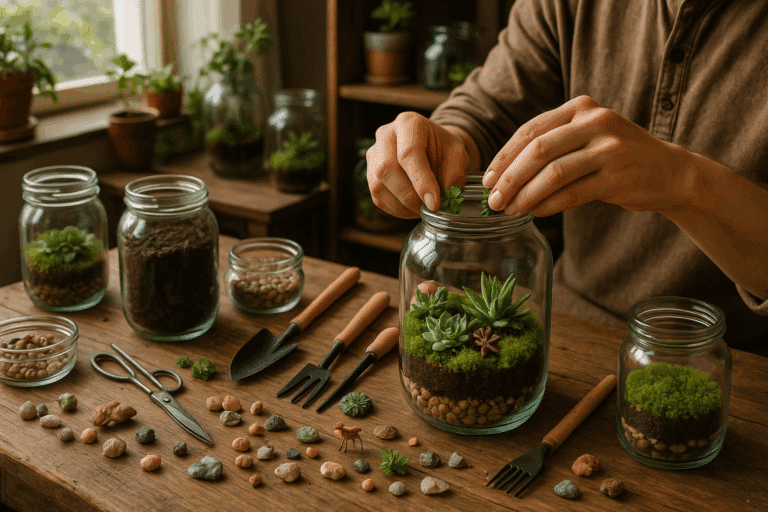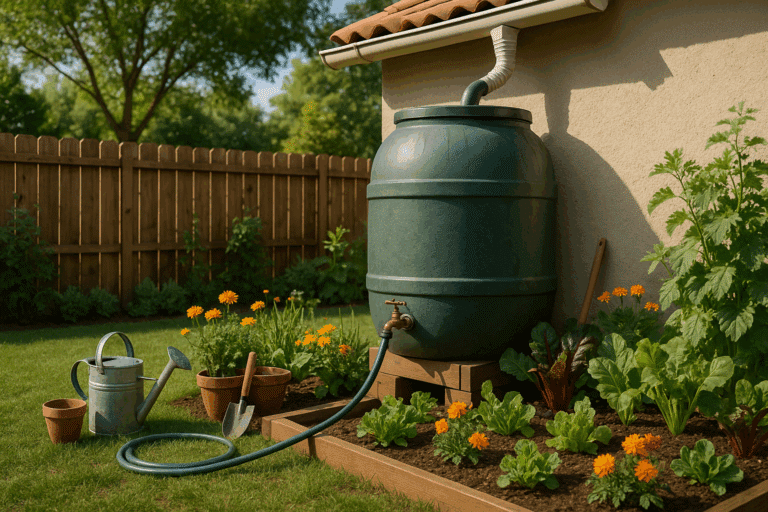Turning discarded materials into practical and aesthetic objects not only reduces the strain on our environment, but also gives a satisfying sense of accomplishment. One such example of upcycling we are focusing on today is the transformation of simple tin cans into stylish, unique planters.🌱
The concept of upcycling is not new, but the way it’s being embraced and integrated into our lives is definitely worth noting. By creating stylish new homes for our plants using tin cans, we combine the best of sustainability, design, and practicality.
In this article, we will delve into the intricacies of upcycled tin can planters, guiding you through the process, and sharing expert tips and tricks. Regardless of whether you’re a seasoned gardener, a DIY enthusiast, or someone simply looking to brighten up their living space, this guide will serve as a comprehensive manual.✨
What awaits you in this guide?
Through the course of this in-depth discussion, we will explore various aspects related to upcycled tin can planters. We begin by discussing the concept of upcycling and its impact on sustainability. We also tackle the question of why tin cans make excellent planters, examining their benefits and limitations.
Next, we guide you step-by-step through the process of creating your very own tin can planter, covering everything from materials needed, the actual crafting process, to the aftercare. We’ll also provide alternatives and suggestions, ensuring you can customize your planter to match your aesthetic preferences.🛠️
Who can benefit from this guide?
Whether you’re an environmentalist keen on reducing waste, a gardening lover looking to expand your indoor jungle, or a DIY enthusiast interested in upcycling projects, this guide is for you. Even if you’ve never wielded a paintbrush or nurtured a plant before, we assure you – it’s simpler than you think!
Our guide aims to inspire and empower you to create something beautiful and practical while contributing positively to the environment. We promise you’ll finish reading this article with a clear understanding of how to transform tin cans into fabulous planters, plus the confidence to put this knowledge into action.🌿
Join the Upcycling Revolution
Upcycling is not just about transforming waste into something useful; it’s a revolution, a lifestyle, a statement. It’s about taking responsibility for our environment and finding innovative ways to reduce waste. And what better way to join this revolution than by transforming something as common as a tin can into a stylish new home for your plants?
Ready to embark on this exciting journey? Then strap in, because we’re about to dive deep into the world of upcycled tin can planters. Let’s transform your space and give your plants a stylish new home!
Reimagine Your Space with Upcycled Tin Can Planters
Creating upcycled tin can planters is not only a fantastic way to give your plants a stylish new home, but it’s also a sustainable, budget-friendly option that adds a unique touch to any space. Whether you’re a seasoned plant enthusiast or a beginner looking for an innovative way to display your growing plant collection, upcycled tin can planters offer an abundance of possibilities. This article aims to provide an in-depth guide on transforming your space using these eco-friendly alternatives. Let’s get started!
Before delving into the how-to, it’s essential to understand why upcycling is such a powerful concept. Upcycling refers to the process of converting old or discarded materials into something useful and often beautiful. It’s a creative and environmentally friendly solution to reduce waste and promote sustainability. Plus, it adds a unique and personal touch to your home decor, making it a win-win situation for you and the environment.
Now, let’s dive into the world of upcycled tin can planters and how you can create your very own.
Choosing the Right Tin Can: Size Matters
One of the first steps in creating your upcycled tin can planter is selecting the right can. The size of the can will largely depend on the type of plant you wish to house. For example, succulents and small cacti will thrive in smaller cans, while larger indoor plants may require a more substantial can, such as an old coffee can. Keep in mind that the can must be deep enough to allow for ample root growth.
For a more detailed comparison, refer to the table below:
| Type of Plant | Recommended Can Size |
|---|---|
| Succulents | Small tin cans (e.g., tuna cans) |
| Small Cacti | Medium tin cans (e.g., soup cans) |
| Larger Indoor Plants | Large tin cans (e.g., coffee cans) |
Once you’ve selected the right can, it’s time to transform it into a suitable home for your plant.
Transforming Your Tin Can Into a Planter
First things first, clean your selected tin can thoroughly. Remove any residual food or labels and ensure it’s dry before moving onto the next step. Safety is paramount when dealing with tin cans; the edges can be sharp, so use caution when handling them. You might find it helpful to use a pair of heavy-duty gloves.
Next, you’ll need to create drainage holes at the bottom of your can. Adequate drainage is crucial for the health of your plants, as it prevents water logging and root rot. Use a hammer and a nail or a drill to create these holes. Remember, the number of drainage holes needed can vary depending on the size of your can and the type of plant you’re planning to house. Generally, a few holes distributed evenly across the bottom of the can should suffice.
Now comes the fun part – personalizing your tin can planter! You can paint, use fabric, apply decorative paper, or even wrap the can in twine. The possibilities are endless and limited only by your creativity. This process is thoroughly explained in the video “DIY Upcycled Tin Can Planters” by HGTV Handmade on YouTube.
Selecting the Right Soil and Plant
The type of soil you use in your planter is just as important as the planter itself. Different plants require different types of soil, so it’s essential to do your research. Generally, indoor plants thrive in a well-draining, nutrient-rich potting mix. You can purchase ready-made potting mix or create your own using a combination of ingredients like compost, perlite, and peat moss.
When it comes to selecting the right plant, consider the size of your planter, the light conditions in your space, and how much care and attention you can provide. If you’re a beginner, you might want to start with low-maintenance plants like succulents, snake plants, or pothos.
Caring for Your Upcycled Tin Can Planter
Once you’ve planted your chosen plant in your newly created tin can planter, it’s time to learn how to care for it. While the specific care instructions will depend on the type of plant, there are a few general tips that can help ensure your plant thrives.
Firstly, ensure your plant gets the right amount of light. Most indoor plants require bright, indirect light. However, some plants, like succulents, need a few hours of direct sunlight every day. Secondly, avoid overwatering your plants. Wait until the top inch of soil is dry before watering again. Finally, remember to feed your plants. Most indoor plants benefit from a dose of all-purpose plant food every couple of months.
Transforming your space with upcycled tin can planters is not just about adding a touch of green; it’s about creating an environment that you love. So, let your creativity run wild and make your space truly your own. Happy planting!

Conclusion
In conclusion, the technical landscape of IT and engineering is continually evolving. We’ve covered a significant amount of ground in this article, delving deep into complex concepts, providing useful context, and presenting actionable insights. This material is valuable, as it affords us a more profound understanding of the intricate world of software engineering and its impact on our everyday lives.
To recap, we first explored the fundamentals of software engineering, breaking down its key components into manageable chunks. We discussed the importance of various aspects such as programming languages, software testing, project management, and software development lifecycle, among others. We then delved into the importance of understanding and employing best practices in software engineering. This involves using a systematic and disciplined approach to software design, development, and testing, which significantly boosts the quality of the final product. 🎯
Next, we touched upon the current trends in the IT and engineering fields, including the rise of machine learning and AI, data science, cybersecurity, and the Internet of Things (IoT). All these elements are reshaping the landscape of the industry, introducing innovative solutions that are pushing the boundaries of what’s possible with technology. 💡
We also highlighted the critical role of technical documentation in the software development process. Clear, concise, and accurate documentation ensures that everyone involved in a project understands their responsibilities and can work together effectively towards a common goal. 📝
Finally, we underscored the importance of continuing education and staying up-to-date with the latest trends and advancements in the field. This is vital for anyone working in IT or engineering, as the pace of technological change is relentless. 🚀
In light of the above, it is clear that software engineering is a dynamic, challenging, and exciting field that offers endless opportunities for growth and development. I hope this article has offered some valuable insights and inspired you to delve deeper into the subject. Whether you’re a seasoned professional or just starting your journey, remember: the key to success lies in a combination of solid technical skills, a thirst for knowledge, and the courage to embrace new challenges. 👏
Remember, the learning doesn’t stop here. There are numerous resources available online to help you keep expanding your knowledge base. Check out sites like Stack Overflow, GitHub, and IEEE Xplore, among others, for more detailed information and technical discussions.
As always, your feedback and comments are highly appreciated. If there are any points you’d like us to expand on or specific topics you’re interested in learning more about, feel free to leave a comment below. Don’t forget to share this article with your network to help spread the knowledge! 💼
Thank you for taking the time to read this article. I look forward to sharing more insights and learning from your experiences in the future.
Keep learning, keep growing, and keep pushing the boundaries of what’s possible with technology. 💪



